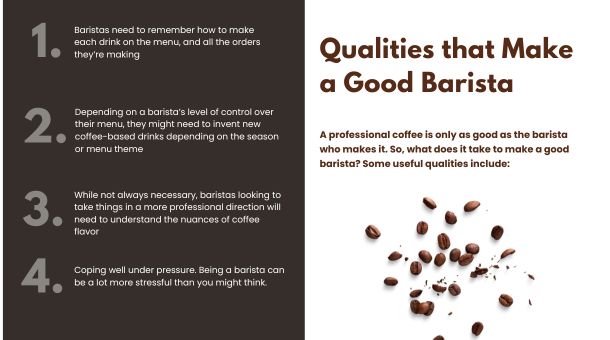What is a Barista Turning Drinks into Art? What is a Barista Turning Drinks into Art?What is a Barista Turning Drinks into Art?
When you step into a coffee shop, you may be greeted by the pleasant aroma of fresh coffee and the sound of steam from the espresso machine. However, what catches your eye may be the intricate designs adorning the top of your latte or cappuccino.
These designs are not just simple decorations; they are the work of a barista turning drinks into art. A skilled barista can transform a simple cup of coffee into a beautiful masterpiece, making each drink a unique and personalized experience for the customer.
In this article, we will explore the world of barista art, its history, and the techniques used by baristas to create these stunning designs. Below, you’ll learn the answer to what a barista is and some useful information about the term.
Who is a barista?
What is a Barista Turning Drinks into Art? What is a Barista Turning Drinks into Art?What is a Barista Turning Drinks into Art?
A barista is a skilled professional who is trained in the art of coffee-making. They typically work in coffee shops, cafes, or restaurants and are responsible for preparing and serving various coffee-based drinks to customers.
Baristas know different coffee bean types, brewing methods, and the equipment needed to make a perfect cup of coffee. They also have expertise in latte art, which involves creating intricate designs in the frothy milk atop a latte or cappuccino. A barista requires attention to detail, good communication skills, and excellent customer service.
What do they do?
A barista’s main responsibilities include the following:
- Preparing coffee drinks
- Maintaining equipment
- Interacting with customers
- Cash handling and inventory management
- Creating a welcoming environment
The Origin of the Coffee Barista
Unsurprisingly, the barista is an Italian term. Its original meaning is “bartender” and refers to someone serving alcoholic and non-alcoholic drinks.
This includes coffee, which is how the term came to be used in other countries for a coffee-specific worker.
Coffee and baristas are used interchangeably in the US and other countries (such as Canada, the UK, etc.). This is partly because English already uses the words bartender, and “coffee preparer” or “coffee worker” is wordy and a bit reductive.
What is latte art, and how do baristas create it?
Latte art is a technique baristas use to create intricate designs in the frothy milk layer on top of espresso-based drinks like lattes and cappuccinos. The designs can range from simple hearts and flowers to more complex patterns like swans and rosettas.
To create latte art, baristas first pour steamed milk into a shot of espresso, creating a creamy foam on the top layer. They then use a small pitcher to pour the milk into the espresso in a specific pattern, manipulating the flow of milk and foam to create the desired design. The process requires precision, as even the slightest mistake can ruin the design.
What are the different types of coffee drinks that baristas can create?
Baristas can create various coffee drinks using different brewing methods and ingredients. Some of the most common types of coffee drinks that baristas can prepare to include:
- Espresso: A shot of concentrated coffee made by forcing hot water through finely-ground coffee beans.
- Americano: A shot of espresso diluted with hot water to create a milder coffee flavor.
- Latte: A coffee drink made with espresso and steamed milk, often topped with latte art.
- Cappuccino: A coffee drink with equal parts espresso, steamed milk, and foam.
- Mocha: A latte with added chocolate syrup or powder.
- Macchiato: A shot of espresso topped with a dollop of foamed milk.
- Flat White: A coffee drink made with espresso and steamed milk, similar to a latte but with a higher proportion of coffee to milk.
- Iced Coffee: A coffee drink made with chilled coffee, often served with ice and milk or cream.
- Nitro Cold Brew: A cold brew coffee infused with nitrogen gas to create a creamy, smooth texture.
- Frappuccino: A blended coffee drink made with ice, milk, and various flavorings, often topped with whipped cream.
Qualities that Make a Good Barista:

A professional coffee is only as good as the barista who makes it. So, what does it take to make a good barista? Some useful qualities include the following:
- Good memory: Baristas must remember how to make each drink on the menu and all their orders.
- Creativity: Depending on a barista’s level of control over their menu, they might need to invent new coffee-based drinks depending on the season or menu theme.
- A good palate: While not always necessary, baristas looking to take things in a more professional direction will need to understand the nuances of coffee flavor.
- Coping well under pressure: Being a barista can be much more stressful than you might think.
What is the role of a barista in a coffee shop or café?
A barista plays a crucial role in a coffee shop or café. Some of their primary responsibilities include:
Preparing coffee drinks:
Baristas prepare coffee drinks using different brewing methods, including espresso, drip, and pour-over coffee. They measure and grind coffee beans, brew coffee, and add milk, syrups, and other ingredients as per the customer’s order.
Maintaining equipment:
Baristas are responsible for keeping the coffee-making equipment clean and in good working condition. They perform routine maintenance tasks, such as descaling and replacing parts when needed.
Providing excellent customer service:
Baristas are the face of the coffee shop or café and interact with customers daily. They take orders, answer questions, and provide recommendations for customers unsure of what to order. Baristas also handle cash registers, process payments, and maintain accurate daily sales records.
Creating a welcoming environment:
Baristas help to create a warm and inviting atmosphere in the coffee shop or café. They maintain a clean and organized workspace and are courteous and friendly to customers, making them feel at home.
Training and development:
Baristas may be responsible for training new staff members on how to make coffee drinks and use coffee-making equipment. They may also attend training sessions to learn new brewing techniques and keep up with industry trends.
What are the essential skills required to become a professional barista?
To become a professional barista, some of the essential skills required are:
- Knowledge of coffee
- Attention to detail
- Customer service
- Time management
- Communication skills
- Creativity
- Physical agility.
- Cleanliness
How can you train to become a skilled barista?
To become a skilled barista, you can consider the following training options:
On-the-job training: Many coffee shops and cafes offer on-the-job training for new baristas. This allows you to learn while working and gain practical experience making different coffee drink types.
Coffee schools and workshops: Many specialty coffee schools and workshops offer barista training programs that cover everything from basic coffee brewing to latte art. These programs usually offer hands-on training with experienced instructors.
Online courses: Several online courses and certifications cover the basics of coffee brewing, equipment, and techniques. Some of these courses also offer live video training sessions with instructors.
Self-study: You can also learn the basics of coffee brewing and barista techniques by reading books, watching videos, and practicing at home. This method requires self-discipline and dedication but can be a cost-effective way to gain knowledge and skills.
Apprenticeships: Some coffee shops and cafes offer apprenticeships to aspiring baristas. This involves working under the guidance of an experienced barista who provides hands-on training and mentorship.
Final Thoughts
As you can see, there’s much more to being a coffee barista than simply making a coffee. It’s a complex profession that can provide useful lifelong skillsets.
Becoming a skilled barista requires dedication, practice, and a willingness to learn. Whether you choose on-the-job training, formal courses, or self-study, many options are available to help you develop the essential skills needed to create great coffee drinks.
As a barista, you play a vital role in providing customers with a quality coffee experience, and your skills and knowledge can make all the difference. So, if you’re passionate about coffee and want to pursue a career as a barista, many opportunities are available to help you achieve your goals.
What is a Barista? Turning Drinks into Art What is a Barista? Turning Drinks into Art What is a Barista? Turning Drinks into Art What is a Barista? Turning Drinks into Art What is a Barista? Turning Drinks into Art What is a Barista? Turning Drinks into Art What is a Barista? Turning Drinks into Art What is a Barista? Turning Drinks into Art What is a Barista? Turning Drinks into Art

